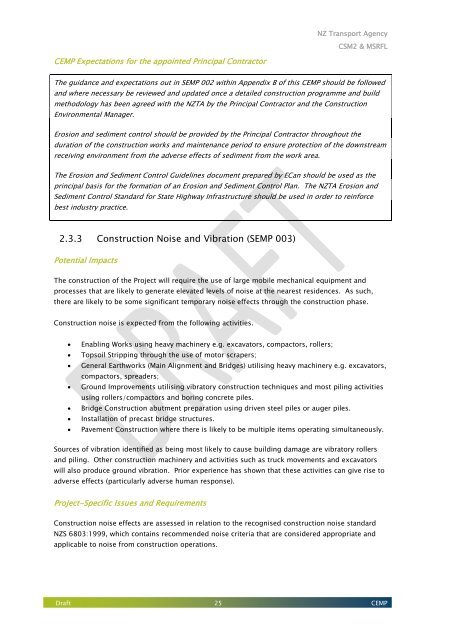CEMP - NZ Transport Agency
CEMP - NZ Transport Agency
CEMP - NZ Transport Agency
You also want an ePaper? Increase the reach of your titles
YUMPU automatically turns print PDFs into web optimized ePapers that Google loves.
<strong>NZ</strong> <strong>Transport</strong> <strong>Agency</strong><br />
CSM2 & MSRFL<br />
<strong>CEMP</strong> Expectations for the appointed Principal Contractor<br />
The guidance and expectations out in SEMP 002 within Appendix B of this <strong>CEMP</strong> should be followed<br />
and where necessary be reviewed and updated once a detailed construction programme and build<br />
methodology has been agreed with the <strong>NZ</strong>TA by the Principal Contractor and the Construction<br />
Environmental Manager.<br />
Erosion and sediment control should be provided by the Principal Contractor throughout the<br />
duration of the construction works and maintenance period to ensure protection of the downstream<br />
receiving environment from the adverse effects of sediment from the work area.<br />
The Erosion and Sediment Control Guidelines document prepared by ECan should be used as the<br />
principal basis for the formation of an Erosion and Sediment Control Plan. The <strong>NZ</strong>TA Erosion and<br />
Sediment Control Standard for State Highway Infrastructure should be used in order to reinforce<br />
best industry practice.<br />
2.3.3 Construction Noise and Vibration (SEMP 003)<br />
Potential Impacts<br />
The construction of the Project will require the use of large mobile mechanical equipment and<br />
processes that are likely to generate elevated levels of noise at the nearest residences. As such,<br />
there are likely to be some significant temporary noise effects through the construction phase.<br />
Construction noise is expected from the following activities.<br />
• Enabling Works using heavy machinery e.g. excavators, compactors, rollers;<br />
• Topsoil Stripping through the use of motor scrapers;<br />
• General Earthworks (Main Alignment and Bridges) utilising heavy machinery e.g. excavators,<br />
compactors, spreaders;<br />
• Ground Improvements utilising vibratory construction techniques and most piling activities<br />
using rollers/compactors and boring concrete piles.<br />
• Bridge Construction abutment preparation using driven steel piles or auger piles.<br />
• Installation of precast bridge structures.<br />
• Pavement Construction where there is likely to be multiple items operating simultaneously.<br />
Sources of vibration identified as being most likely to cause building damage are vibratory rollers<br />
and piling. Other construction machinery and activities such as truck movements and excavators<br />
will also produce ground vibration. Prior experience has shown that these activities can give rise to<br />
adverse effects (particularly adverse human response).<br />
Project-Specific Issues and Requirements<br />
Construction noise effects are assessed in relation to the recognised construction noise standard<br />
<strong>NZ</strong>S 6803:1999, which contains recommended noise criteria that are considered appropriate and<br />
applicable to noise from construction operations.<br />
Draft 25 <strong>CEMP</strong>
















